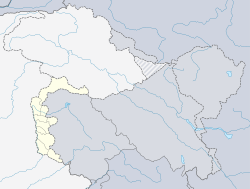Bhimber
|
Bhimber بھمبر |
|
|---|---|
| Door to Kashmir | |

Panoramic view of Bhimber
|
|
| Coordinates: 32°58′50″N 74°04′10″E / 32.980645°N 74.06943°ECoordinates: 32°58′50″N 74°04′10″E / 32.980645°N 74.06943°E | |
| Country | Pakistan |
| Territory | Azad Kashmir |
| District | Bhimber District |
| Established | 7th century AD |
| Government | |
| • Nazim (Chairman City) | Chaudhary, Zain |
| • City Administrator | Raja Shahid Anwar |
| Population (2014) | |
| • Total | 461,000 |
| Time zone | PST (UTC+5) |
| Postal code | 10040 |
| Dialling code | 0092-05828 |
| Website | Official Website |
Bhimber (Urdu: بھمبر) is the chief town of Bhimber District, Azad Kashmir. The town is situated on the border between Azad Kashmir and Pakistan at a distance of about 50 km (31 mi) from Mirpur, about 48 kilometres (30 mi) from Gujrat, about 37 kilometres (23 mi) from Jhelum, about 166 kilometres (103 mi) from Islamabad and about 241 kilometres (150 mi) from Srinagar.
During the seventh century AD, the celebrated Chinese Buddhist monk, scholar, translator and pilgrim to India Hsuan Tsang mentioned Bhimber in his works. The works of Hsuan Tsang were translated into English in 1884 by Samuel Beal a scholar from England.
Bhimber has remained capital city of Chibhal, named after Raja Chib Chand the eldest son of Raja Partab chand who came to Bhimber and established the state after marrying local ruler`s daughter in 1400 A.D. Chibs are direct descendents of Raja Chib Chand .
In Chibs, the first who embraced Islam was Shadaab Khan who is famous as Hazrat Baba Shadi Shaheed. His Hindu name was Raja Dharm Chand Chib. The last ruler of Chibhal was Raja Sultan Khan (1800–1840). Bhimber has been important strategically. It lies on the route that was followed by the Mughal Emperors for their frequent visits to the Kashmir Valley. It is also known as "Baab-e-Kashmir" (Door to Kashmir) because of its importance and geographical location which was ideal for Mughal Emperors to enter Kashmir. Therefore, the Mughals used Bhimber as a staging point for journey to Srinagar. Mughal Emperor Jahangir discussed Bhimber in his book Tuzk-e-Jahangiri. There live different caste peoples, in which mostly are Jatt secondly Rajpoot and 3rd are Mughal and some Gujjar and others.
...
Wikipedia

